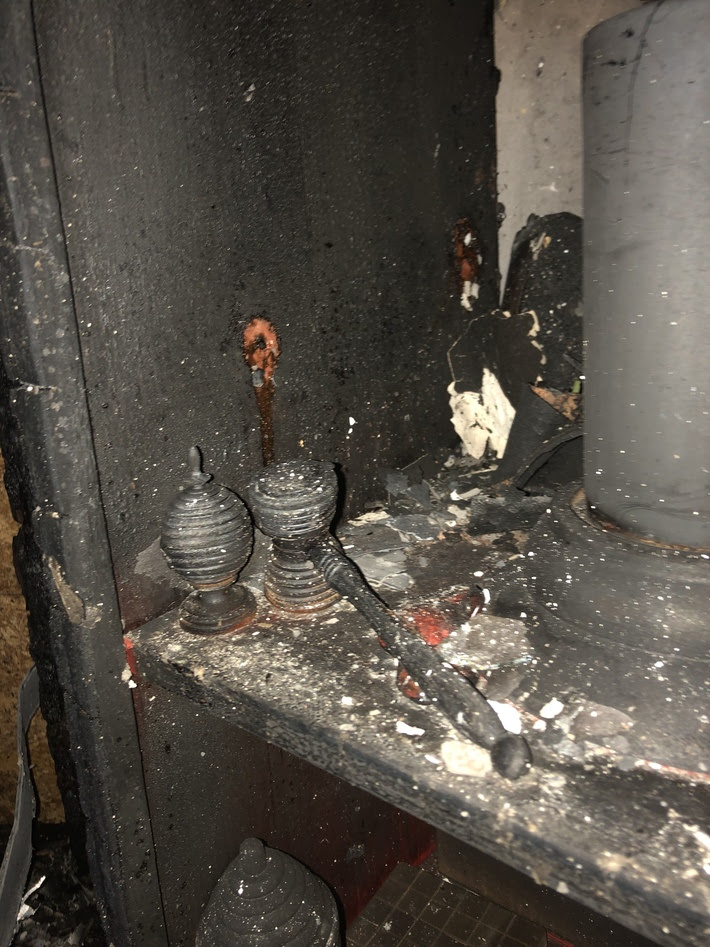

A Different Kind of Magical Fire
by Judge Gary Brown
In the world of magic and collecting, cautionary tales abound: magicians and enthusiasts need to protect rare and expensive equipment, books and collectibles from numerous threats: light, moisture, water, mold, rust, theft and neglect. This is a slightly different story, but one laden with important lessons.
In 2019, a power surge ignited a blazing fire in my home, consuming the house in minutes. Nearly everything we owned was destroyed, damaged by heat, flame or water, and/or contaminated with soot and smoke damage. The results were disastrous‘, though not tragic, as miraculously the entire family — even the dog — was away from the house at the time. Yet the fire wreaked enormous emotional, financial and practical implications and, at this writing, nearly two years later, continue to impact our lives.
The devastation included the near destruction of my magic collection — an assortment of equipment, ephemera and posters gathered during four decades of practice and study of our art. Stored largely in our living room, the area hit hardest by the blaze, the collection included tens of thousands of dollars in apparatus, books and ephemera, some items quite rare, and a few, unique. The gorgeous lithographs that adorned every wall space in my home are entirely gone – the only remnant being burn marks on the scorched walls. Dozens of wands that I built by hand left out on display literally disappeared without a trace. My library of over 400 magic books — including a first edition Houdini work, numerous autographed volumes and early editions of Hoffmann and other magic classics — was at the core of the fire. Irreplaceable notes, routines, plans, diagrams and prototypes are gone. Other pieces were burned beyond recognition or severely damaged.
In the wake of this disaster, I’ve been left with the unpleasant task of trying to catalog these losses for the purposes of insurance coverage. One of the most heartbreaking days I’ve ever spent involved tearing the title pages from the burnt hulks of many of my magic books — carefully collected and curated over many years — as proof of their destruction.
Several historic items that were destroyed may have been one of a kind. For example, nothing remained of a “Green Eyed Thurston” window card, one of my favorite pieces, is now gone forever; in years of studying magic history, I have never seen another.
Other lithographs, including some for Carter, George and Maro, printed by Otis and Friedlander, among others, were entirely consumed.
Much of my throwing card collection, which has been my most fervent collecting interest, was damaged or destroyed. At the same time, a handful of
unique throwing cards, as I’ll discuss below, survived by mere happenstance.
Recognizing that these things happen, and with gratitude that this was not a truly irreparable tragedy, it is my hope that others can learn something from my misfortune. These lessons have been hard and costly. As a result, there are some things that I would urge readers of this journal to consider in order to protect their magic investments.
- Check your insurance – magicians would be well advised to check their “contents” coverage on their homeowners or renters policy, and verify whether their insurance policy covers collectibles. Many policies do not cover “collectible” or antique value of items. Just as one example, a rare, first edition copy of a Houdini book might fetch thousands, while crunched through an adjustor’s spreadsheet has a “replacement value” about a dollar, measured by the depreciated value of a used paperback on Amazon. While not a difficulty in my case, certain homeowners policies may limit or exclude property used for business purposes, which could include magic equipment. Check the limits on your “contents” coverage: your magic books and equipment will, for these purposes, all of your clothes, appliances, furniture and so forth, are probably far more valuable than you imagine. Consider contacting your insurance provider to raise the limits or include “riders” for certain valuable or collectible property. If you think insurance is too expensive, try not having it when you need it….
- Inventory your collection – I cannot overemphasize the value of creating a written inventory and/or a video/photographic record of your collection (as well as other items in your home), and store it remotely. While not a fun activity, given that we have video and photographic equipment integrated with our smartphones, there’s little excuse not to do this. Trying to assemble this information after a disaster — from fragments of records or perhaps by memory — is a formidable and soul-crushing task.
- Curate and cull – remember that though your home might be your figurative castle, the things you store in it are subject to theft, fire, floods, leaks, damage from mold, etc. Should your home really be the situs of museum-quality magic pieces? That’s a decision you must make. But certainly, if it’s something that doesn’t truly bring you joy or insight, it’s just clutter. Similarly, if you’re holding it simply because it’s valuable or might become so, you might want to think about whether that is something that really belongs with you.
- Consider storage methods – How do you store your magic? Here, I want to discuss throwing card collection – hundreds of items that I carefully acquired, studies and organized. The vast bulk of my collection was arranged in archival, acid free sleeves, in a wooden library card catalog box, which was housed in a convenient plastic wicker file box. Read the sentence again and you’ll see that all of the materials I used to store the cards were combustible. Those archival top loaders melted into a big block and caught fire. Miraculously, a few of my truly unique cards, like an original, historic card handled by Cardini, were stored in a tightly sealed wooden box and individually sealed screw downs, and escaped the blaze unharmed. This sort of serendipity cannot be depended upon. — I’ve noticed that Amazon sells a variety of fireproof and waterproof safes, boxes and bags that you may want to consider for important pieces.
- Share your magic and don’t postpone joy! – there are probably a few things that you own – or perhaps many – that would be far more appreciated by someone else. I was very glad that in the months before the fire I had sent some of my unused effects to a teen member of my magic club who lost everything in a fire at the apartment at which he lived. Similarly, shortly before the fire, I had fortuitously mailed a wand, hand-built to celebrate the publication of Wand craft to my friend Larry Hass, Originally, I had planned on saving this gift for our next planned meeting at the Magic & Meaning Conference a few months later, but the excitement of sharing it got the better of me. So if you’re planning on giving away anything from your collection, doing it sooner might be a good idea.
- Digital Backup and Sharing – Keeping notes and/or images of your ideas, scripts and innovations electronically allows you to keep them backed up in the cloud, mitigating the risk of loss in a disaster. Posting images of your unusual collectibles helps ensure they will live on in some form should disaster strike. In this regard, I was pleased that I posted photographs and research about many of my throwing cards at the Propelled Pasteboards [https://throwingcards.blogspot.com] site, so they can still be accessed and studied.
It is, of course, my hope that you take some of these steps and that, like an umbrella packed on a sunny day, the efforts will serve to talismanically ward off disaster. But if it rains, you’ll be glad to have made the investment.
Judge Gary Brown
Judge Brown, a frequent contributor to the Secret Arts Journal and other programs of the McBride Mystery School is, most recently, the author of Wandcraft, Making and Using a Magic Wand. You can contact him and learn more about his many contributions to the art of magic at his website: JudgeBrownMagic.com.










